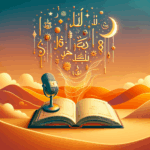The Arabic Alphabet and Its Impact on Literature
Have you ever wondered how the Arabic alphabet has shaped the rich tapestry of literature across the Middle East and beyond? Whether you’re a language enthusiast, a literature lover, or just curious about how alphabets influence culture, this blog post is for you! Let’s dive into the fascinating world of the Arabic script and see how it has left an indelible mark on literature over the centuries. 📚
Table of Contents
1. Introduction to the Arabic Alphabet
2. Historical Significance of the Arabic Script
3. The Arabic Alphabet in Literature
4. Modern Impacts and Global Influence
5. Conclusion
6. FAQ Section
Introduction to the Arabic Alphabet
The Arabic alphabet is a captivating system of writing that has intrigued scholars and linguists for centuries. Comprising 28 letters, this script is written from right to left and has been the backbone of some of the world’s most profound literary works. 🌍 It’s more than just a way to communicate; it’s an art form, with beautiful calligraphy that turns words into visual poetry.
Historical Significance of the Arabic Script
Tracing back to its origins, the Arabic alphabet has its roots in the Nabataean script, which was used by the Nabataeans, an ancient Arab people. The script evolved into its current form by the 4th century CE and rapidly became a significant cultural bridge across regions. It played a crucial role in the Islamic Golden Age, where scholars used it to pen philosophical, scientific, and literary texts that have had a lasting global impact. 🌟
The Arabic Alphabet in Literature
Arabic literature is a treasure trove of stories, poetry, and wisdom. From the timeless tales of „One Thousand and One Nights“ to the profound poetry of Al-Mutanabbi, the Arabic script has been the vessel for expressing emotions, ideas, and cultural narratives. Each letter and word crafted in Arabic literature is a testament to the artistry and depth of the language. 📖
Modern Impacts and Global Influence
In today’s interconnected world, the Arabic alphabet continues to influence global literature and culture. It serves as the script for Arabic, the liturgical language of Islam, which has over a billion followers. Furthermore, the alphabet is used in other languages, such as Persian and Urdu, extending its influence beyond the Arab world. This global reach has fostered cultural exchanges and enriched world literature, making the Arabic script a bridge between East and West. 🌐
Conclusion
The Arabic alphabet is not just a means of writing; it’s a cultural artifact that has woven itself into the fabric of literature and society. Its impact is evident in the rich literary traditions it has nurtured and the global influence it exerts. As we continue to explore the power of language, the Arabic script stands as a remarkable testament to the enduring power of the written word. ✍️
FAQ Section
Q1: What makes the Arabic alphabet unique compared to other alphabets?
A1: The Arabic alphabet is unique due to its right-to-left script, its artistic calligraphy, and its use in a wide range of languages beyond Arabic itself, including Persian and Urdu.
Q2: How has the Arabic script influenced Western literature?
A2: The Arabic script has influenced Western literature through the translation of Arabic works during the Middle Ages, which introduced new scientific, philosophical, and literary ideas to Europe.
Q3: Is the Arabic calligraphy still significant today?
A3: Absolutely! Arabic calligraphy remains a celebrated art form, admired for its beauty and used in modern design, architecture, and art around the world.
Q4: Can learning Arabic literature enhance cultural understanding?
A4: Yes, engaging with Arabic literature can provide deep insights into Arab culture, history, and values, fostering greater understanding and appreciation across cultures.





